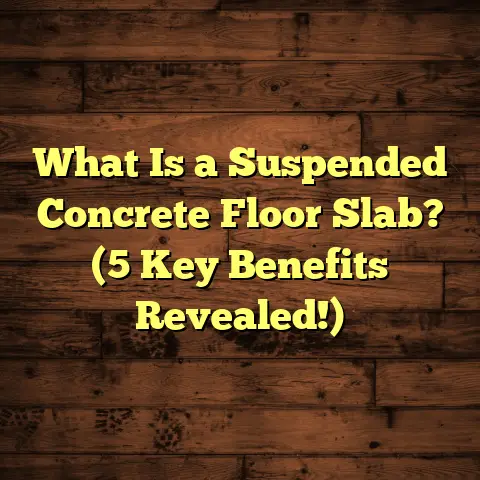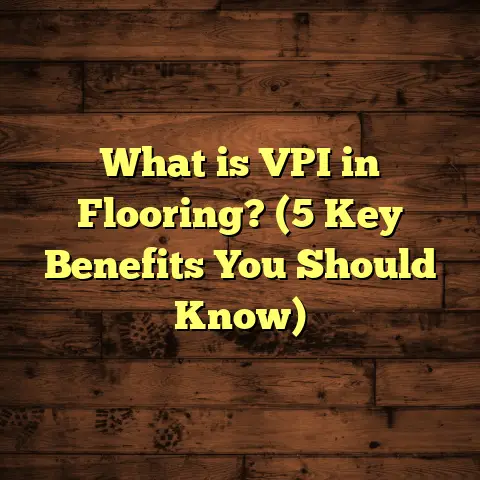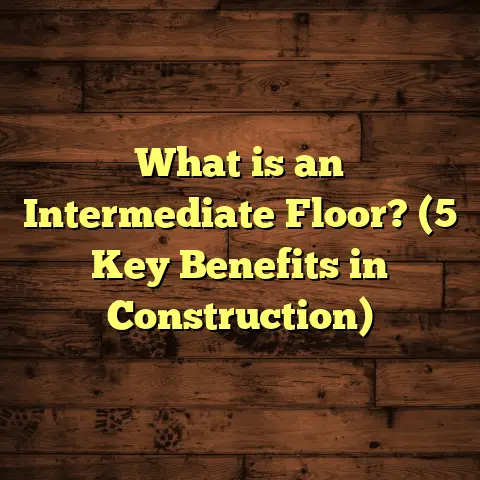What is Bamboo Flooring? (5 Benefits You Didn’t Know About!)
Bamboo Flooring: What Is It, and Why Should You Care?
Lately, I’ve been hearing a lot about bamboo flooring from homeowners, designers, and even contractors looking for alternatives to traditional hardwood. It’s becoming a staple in the flooring world—not just a trend but a serious option many people are considering. The buzz isn’t surprising once you start peeling back the layers. Bamboo flooring offers some unique benefits that go beyond just being “green.”
If you’re curious about this material and wondering if it’s right for your next flooring project, I’m here to share what I’ve learned through years of installing bamboo floors and helping clients make smart choices. Let’s take a closer look at what bamboo flooring really is and why it deserves a spot on your shortlist.
What Exactly Is Bamboo Flooring?
You might already know bamboo as the tall grass that pandas love to munch on, but did you realize it can be transformed into a durable, beautiful floor for your home?
Bamboo flooring is made from bamboo grass stalks rather than hardwood trees. This is important because bamboo grows incredibly fast—much faster than hardwood trees like oak or maple. While most hardwood trees take 20 to 50 years to mature, bamboo reaches full maturity in about 3 to 5 years. This rapid growth rate makes it an attractive option for those concerned with sustainability.
The Manufacturing Process
Here’s a peek behind the scenes at how bamboo flooring is made—something not everyone knows but that really influences the quality of your floor:
- Harvesting: Mature bamboo stalks are harvested by cutting them near the base without uprooting the plant. This ensures new shoots grow back, making bamboo a renewable resource.
- Stripping: The outer layer is peeled off, leaving the inner stalk which is then cut into strips.
- Treatment: These strips are boiled or steamed to remove sugars and starches that could attract insects or cause mold growth. This step also helps stabilize the bamboo.
- Drying: After treatment, the strips are dried thoroughly to reduce moisture content, preventing warping later.
- Lamination: The strips are glued together using formaldehyde-free adhesives. The way they are assembled determines the style:
- Horizontal grain: Strips laid side by side horizontally, showing the bamboo’s nodes.
- Vertical grain: Strips stood on edge vertically for a tighter grain pattern.
- Strand-woven: Bamboo fibers shredded and compressed under high pressure with resin for extremely hard planks.
- Pressing: The glued strips are pressed under high pressure to form solid boards.
- Finishing: Boards are sanded smooth and coated with protective finishes such as aluminum oxide or polyurethane. Some are carbonized by heating to darken their color naturally.
This process explains why bamboo floors vary so much in appearance and durability.
How Bamboo Flooring’s Technical Specifications Stack Up
I’ve worked with many flooring materials over the years, and I find that understanding technical specs helps clients feel confident about their choices. Here’s what bamboo flooring brings to the table:
- Hardness: Bamboo’s hardness depends on its type.
- Natural horizontal or vertical bamboo scores between 1,200 and 1,400 on the Janka hardness scale (similar to red oak).
- Strand-woven bamboo can reach up to 3,000 Janka points—double the hardness of many hardwoods.
- Thickness & Dimensions: Most bamboo planks come in thicknesses ranging from 3/8 inch to 3/4 inch and widths between 3 to 5 inches. Wider planks offer a more modern look but may require acclimation for stability.
- Moisture Content: Properly manufactured bamboo has a moisture content around 6-9%, which helps prevent expansion or contraction after installation.
- Density: Strand-woven bamboo is denser than traditional hardwoods due to its compressed fibers, contributing to its strength.
- Finish Options: Bamboo floors come pre-finished with durable coatings like aluminum oxide that protect against scratches and UV fading.
Environmental Certifications
Many bamboo manufacturers seek certifications such as:
- FSC (Forest Stewardship Council): Verifies responsible sourcing.
- CARB (California Air Resources Board) compliance: Ensures low formaldehyde emissions.
- FloorScore® or GREENGUARD Gold: Certifies low VOC emissions for indoor air quality.
When I’m choosing materials for clients with health concerns or green building goals, I always check for these certifications.
Why Bamboo Flooring Has Become So Popular
I want to share some stories from my own projects that highlight why people love bamboo floors beyond just their eco-friendly label.
Story #1: The Young Family Upgrade
One family I worked with had three young kids and a very active lifestyle. They wanted something durable but also allergy-friendly since one child had asthma. We settled on strand-woven bamboo flooring with a matte finish for better grip and fewer dust traps.
After two years, they reported hardly any scratches or dents despite rough play and pets running around. Plus, the indoor air quality seemed improved since they switched from carpeted rooms to bamboo floors. They told me it was one of their best home investments.
Story #2: Modern Office Space
A local startup wanted an office floor that reflected their sustainable values but still felt professional and stylish. We installed vertical grain bamboo flooring with a carbonized finish to give deeper tones without staining.
The installation took just two days with minimal disruption. Employees appreciated the warmer atmosphere compared to cold concrete floors, and management liked knowing their choice supported sustainable forestry practices.
Five Benefits of Bamboo Flooring You Might Not Know
There’s more to bamboo than meets the eye. You probably already guessed that it looks good and is eco-friendly, but here are five benefits that often surprise people:
1. It’s Surprisingly Durable (Especially Strand-Woven)
Durability is usually one of the first questions I get. People assume grasses aren’t tough enough for floors—but strand-woven bamboo flips that idea on its head.
By shredding bamboo fibers and compressing them with resin under intense pressure, manufacturers produce planks with exceptional density and hardness. This makes strand-woven bamboo twice as hard as red oak hardwood floors.
What does this mean practically? If you have pets, kids, or high foot traffic areas, strand-woven bamboo resists dents and scratches far better than traditional hardwoods or laminates.
Data Snapshot
- Red oak Janka hardness: ~1,290
- Strand-woven bamboo Janka hardness: 2,800–3,000
- Maple hardwood Janka hardness: ~1,450
I’ve tested scratch resistance on several samples during installations—the strand-woven planks held up remarkably well against keys, pet claws, and moving furniture.
2. Stylish With Unique Grain Patterns
Bamboo’s natural look is distinct from typical hardwood grains. Depending on how the strips are arranged:
- Horizontal grain shows nodes resembling natural joints.
- Vertical grain offers a clean linear pattern.
- Strand-woven looks almost like exotic wood with a random fiber texture.
This variety lets you pick styles from rustic farmhouse charm to sleek contemporary vibes.
In one client’s beach house renovation, we used carbonized horizontal grain bamboo for warmth that paired perfectly with coastal decor—yet was more resistant to humidity than traditional wood.
3. Faster Installation Means Less Hassle
Time is money in construction projects. Bamboo flooring often comes pre-finished from the factory with durable coatings already applied. That means no sanding or finishing on-site!
From my experience, this saves days compared to site-finished hardwood floors which require sanding, staining, sealing, and curing time.
For example, in a recent condo renovation where tenants were temporarily relocated, we completed bamboo floor installation within two days—allowing the family to move back quickly without lingering paint fumes or dust.
4. Sustainable Choice With Real Environmental Benefits
Bamboo’s environmental story is compelling once you dig into the numbers:
- It grows up to four feet per day under ideal conditions.
- A single hectare can produce up to 62 tons of biomass annually.
- Harvesting doesn’t kill the plant; rhizomes regenerate new shoots.
- Bamboo sequesters roughly 30% more CO₂ than comparable hardwood forests.
I’ve visited bamboo farms in Asia during supplier vetting trips and saw firsthand how sustainable management practices ensure healthy ecosystems while supporting local communities.
5. Healthier Indoor Air Quality
Indoor air quality often flies under the radar when choosing flooring materials. Many wood floors use adhesives or finishes that emit VOCs (volatile organic compounds), which can trigger allergies or respiratory issues.
Bamboo flooring is generally manufactured using low-VOC adhesives and water-based finishes compliant with strict indoor air quality standards like FloorScore® or GREENGUARD Gold certification.
One client whose child had severe allergies switched from carpet to bamboo floors throughout their home. They noticed reduced dust accumulation and fewer allergy flare-ups—a real game-changer for them.
My Personal Take on Bamboo Flooring in Real Projects
Over 10 years of being in this business, I’ve installed hundreds of floors—from oak and walnut hardwoods to vinyl planks and carpet—but bamboo remains one of my favorites for specific reasons:
- It balances aesthetics with durability beautifully.
- It’s versatile enough for many design styles.
- The installation goes smoother due to factory finishes.
- It supports environmentally conscious choices without sacrificing quality.
- I love how clients come back happy years later with little maintenance needed.
One renovation I’ll never forget involved an elderly couple downsizing into a smaller home. They wanted something warm underfoot but easy to maintain since bending down was harder now. Bamboo fit perfectly—they got a beautiful floor that cleaned up easily and still looked great after multiple grandchildren visits!
Things You Should Keep in Mind Before Choosing Bamboo
While I’m a big fan of bamboo flooring, it’s not perfect for every situation.
Quality Varies Widely
Not all bamboo floors are created equal. Strand-woven types generally offer better durability than horizontal or vertical grain ones made with lower-quality adhesives or poor pressing techniques.
Cheap imports sometimes cut corners by using formaldehyde-based glues or less stable manufacturing methods leading to warping or delamination over time.
Always ask about:
- Type of bamboo plank (strand-woven vs horizontal/vertical)
- Certification (FSC, CARB)
- Warranty length
- Finish type (aluminum oxide preferred)
Moisture Sensitivity Means No Bathrooms or Basements
Bamboo handles humidity better than many hardwoods but isn’t waterproof. It can swell or warp if exposed to standing water or very high moisture levels for extended periods.
I avoid recommending bamboo in bathrooms or damp basements unless there’s excellent waterproofing underneath and good ventilation.
Proper Acclimation Is Essential
Like all natural materials, bamboo needs time to adjust to your home’s humidity before installation—usually 48-72 hours in the room it will be installed in.
This step prevents issues like buckling or gaps after installation caused by moisture changes.
Maintenance Tips for Longevity
Keeping your bamboo floor looking fresh doesn’t require much effort:
- Dry mop or vacuum regularly to remove grit.
- Clean spills immediately with a damp cloth.
- Avoid harsh chemical cleaners; use pH-neutral products designed for wood or bamboo.
- Use felt pads under furniture legs.
- Refinish every few years if you notice wear (strand-woven floors can be sanded multiple times).
How Bamboo Compares With Other Flooring Types
When clients choose new floors, I get questions about how bamboo compares with other options like hardwood or laminate:
| Feature | Bamboo Flooring | Hardwood Flooring | Laminate Flooring |
|---|---|---|---|
| Durability | High (strand-woven highest) | Medium-high (species-dependent) | Medium (surface wear varies) |
| Environmental Impact | Very high (renewable grass) | Variable (depends on harvesting) | Low to moderate |
| Installation Speed | Fast (pre-finished planks) | Slower (site finishing) | Fast |
| Cost (Installed) | $5 – $8 per sq.ft | $6 – $12 per sq.ft | $2 – $5 per sq.ft |
| Maintenance | Low (easy cleaning) | Moderate | Moderate |
| Appearance | Unique grain patterns | Wide variety | Wood-like patterns |
| Moisture Resistance | Moderate | Low | Moderate |
Case Study: Bamboo Flooring in a Family Home Renovation
Let me share a detailed case study from one of my recent projects:
Client: The Thompsons—young family with two kids and a dog
Location: Suburban home in Oregon
Project Goal: Replace old carpet in living room and hallway with durable, eco-friendly flooring
Material Chosen: Strand-woven bamboo flooring with matte finish
Why Bamboo?
The Thompsons wanted something hard-wearing but also sustainable since they care about environmental impact. They liked the look of natural wood but were worried about scratches from kids’ toys and pets’ nails.
Process:
We removed carpet and prepared subfloor over two days. Bamboo planks were acclimated for 72 hours before installation. The pre-finished strand-woven boards were installed using floating method over underlayment for sound absorption.
Outcome:
Installation completed in three days total including prep time without disrupting family schedule too much. The Thompsons loved how easy it was to clean compared to carpet—no more stains or allergens trapped in fibers.
Follow-up at One Year:
Minimal wear visible despite heavy use; dog claws caused no damage; kids’ crayons wiped off easily; indoor air quality noticeably improved according to mom’s feedback.
Exploring Design Possibilities With Bamboo Flooring
If you think bamboo is just plain light-colored grass boards, think again! There are plenty of design options:
- Color Variations: From natural honey tones to carbonized rich browns.
- Plank Widths: Narrow strips for traditional looks; wide planks for modern spaces.
- Grain Patterns: Horizontal nodes add texture; vertical grains provide sleek uniformity.
- Finish Types: Matte for rustic charm; glossy for elegant shine.
- Custom Inlays & Borders: Some manufacturers offer decorative edges or patterns using different colors of bamboo or combined with hardwood accents.
By mixing these elements creatively, you can tailor your floor exactly how you want it.
Frequently Asked Questions About Bamboo Flooring
I get these questions all the time from friends and clients:
Q: Will bamboo fade in sunlight?
A: Like hardwoods, prolonged direct sunlight can cause slight color changes over time. Using window treatments or UV-resistant finishes helps minimize this effect.
Q: Is bamboo slippery?
A: Pre-finished bamboo floors usually have enough texture for safe footing; matte finishes reduce slipperiness further compared to glossy ones.
Q: Can I refinish bamboo floors?
A: Yes! Strand-woven floors can typically be refinished multiple times depending on thickness; horizontal/vertical grains less so due to thinner wear layers.
Q: Are bamboo floors noisy?
A: Noise depends on installation method—floating floors may have slight hollow sounds if not installed properly; proper underlayment reduces sound issues significantly.
Final Thoughts From My Toolbox
Choosing flooring can feel overwhelming given all the options out there. But if durability, style, environmental responsibility, and ease of installation matter to you like they do me and my clients, then bamboo flooring definitely deserves serious consideration.
I’ve seen firsthand how it performs beautifully in homes with kids and pets—and how it contributes positively to indoor air quality and sustainability goals without breaking the bank.
If you want help figuring out whether bamboo fits your project—whether a cozy living room upgrade or commercial space makeover—just ask! I’m happy to share tips from my toolbox and help guide you through selecting the right product and installation method tailored for your needs.
If you want more specific advice like cost estimates based on your location or maintenance plans customized for your lifestyle, I can help dig into those details too! Just let me know what you’re thinking about next for your floors.





